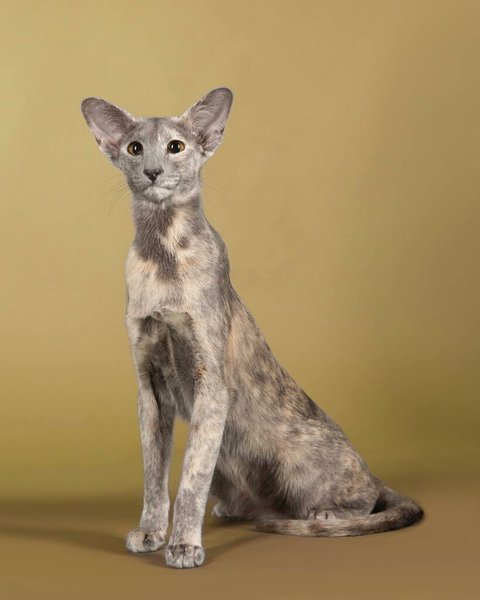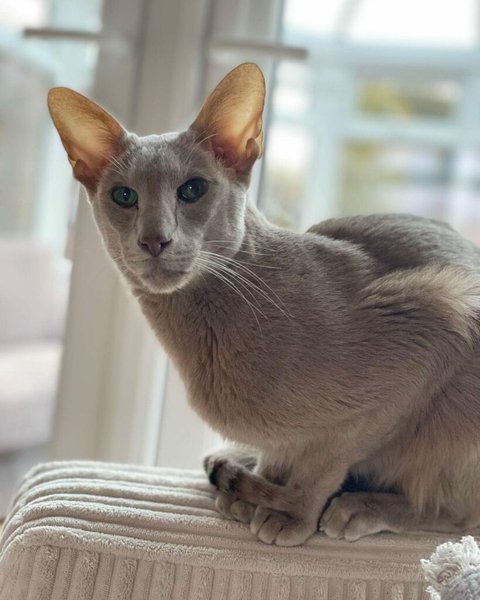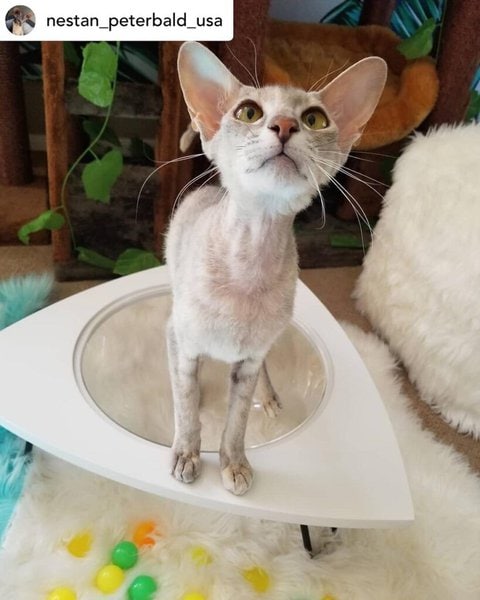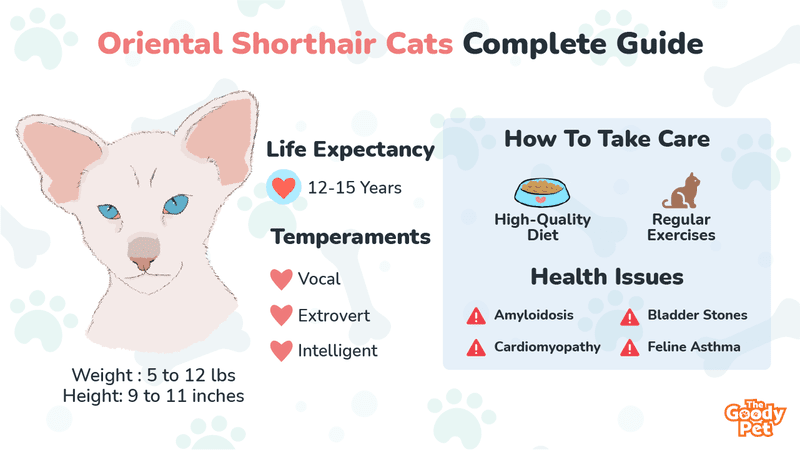Graceful and sleek, the Oriental Shorthair is one of the most lovable feline breeds you’ll ever come across, but a demanding nature means it can be difficult to raise one. Read on to find out how to cope with this cat’s excessive behavior.
Firstly, what is an Oriental Shorthair Cat? An Oriental Shorthair Cat is a hybrid of the popular Siamese cat that was developed to provide more color variations. The modern-day Oriental Shorthair is available in over 300 different colors and patterns and is known for its excessive demand for attention.
In today’s article, we’ll be taking an in-depth look at the temperament of Oriental Shorthairs, grooming and feeding tips, common health issues, plus how to cope with their unusually high attention demands! But before we go into these, let’s see how you can tell if a cat is oriental, and how to distinguish this breed from Siamese cats.
What Do Oriental Shorthair Cats Look Like?
The most distinctive feature of an Oriental Shorthair cat is its sleek and unique body structure. Oriental shorthairs typically have an elongated torso, with long necks and legs, and a wedge-shaped head. The Oriental’s shoulders and hips are fairly wide and in proportion with the rest of the body.
The Oriental Shorthair has medium-length fur, and there are over 300 color variations and combinations possible with its coat! It is also worth noting that your cat is part Oriental if it has either blue or green almond-shaped eyes.
Large, pointed ears, with a suitably wide base, and a long, thin tail with a tapered end further contribute to the Oriental Shorthair’s different look from typical domestic cats.

Size
Oriental Shorthairs are medium-sized cats, with the males capable of growing to healthy weights ranging between 8 to 12 lbs. And as expected, adult female shorthairs are smaller than their male counterparts, with weights typically ranging between 5 to 8 lbs.
Orientals are fairly tall cats, and when they are on four legs, they stand anywhere between 9 to 11 inches. As stated earlier, Orientals have long bodies, and at full stretch, an adult Shorthair cat can reach lengths between 11 to 14 inches.
Origin
Oriental Shorthair Cats made their first public appearance in Britain, somewhere in the late 1950s to early 1960s, as a cross-breed of the popular Siamese cat, Domestic Short-Hair, and Russian Blue.
The objective of the cross-breeding process was simple – A cat that looks and behaves like the Siamese cat, but with more coat colors and patterns; In other words, the modern-day Oriental Shorthair cat.
Do Oriental Shorthairs Have Health Problems?
Lifespan
On average, Oriental Shorthair cats will live for anywhere between 12 to 15 years.

Common Health Issues
Oriental Shorthairs are generally healthy cats, and you can expect not to spend a mini fortune at the vet’s while your cat is alive. Regardless, an Oriental Shorthair cat is predisposed to health conditions typical with other Siamese cats, such as:
Amyloidosis
This refers to a condition in which amyloids responsible for several body growth activities in Shorthairs are deposited outside of cells in organs and tissues; This, in turn, leads to a breakdown of such organs and tissues.
Amyloidosis can be fatal for Oriental Shorthairs if amyloids, somehow, find their way into critical organs such as the heart, liver, or kidney.
Typical symptoms and effects of amyloidosis in Oriental Shorthairs include severe weight loss, slow movement, loss of appetite for food, and increased urination and drinking. In some cases, a shorthair suffering from this condition might suffer fluid build-up under the skin, thereby leading to a swollen appearance.
It should be noted that there is no known medical treatment for amyloidosis in cats. And the best that can be done is to stabilize the suffering cat while treating the underlying conditions and symptoms.
Progressive Retinal Atrophy
Progressive Retinal Atrophy (PRA) refers to an inherited genetic condition that causes a gradual degeneration of the retina in Oriental Shorthairs; This degeneration, in turn, leads to gradual loss of sight in shorthairs, and in the long run, complete blindness.
On a sad note, there is no known treatment for PRA, and neither is there a way to manage deteriorating sight in affected Shorthair cats. On the bright side, thanks in part to their sharp sense of smell and a great memory, Oriental Shorthairs suffering from PRA can adapt to the gradual loss of sight typical with this condition.
Other Health Issues
Apart from the aforementioned health conditions, your Oriental cat is also liable to suffer from diseases such as bladder stones, feline asthma, and mast cell cancer. Your Oriental Shorthair might also fall victim to dilated cardiomyopathy, although this condition is relatively rare.
How To Take Care Of Oriental Shorthair Cats?
Diet
Due to their high energy requirements, Oriental Shorthairs need to be fed high-quality cat food that is rich in fat and protein. And at the same time, your Shorthair’s diet should contain minimal carbohydrates.
If you’re unsure of what to feed your Oriental Shorthair, one diet plan I recommend you place your cat on is the Nom Nom Cat Food.
The Nom Nom meal contains all the essential nutrients needed for healthy Shorthair growth, and impressively manages to incorporate food ingredients that Shorthairs enjoy feeding on – even the pickiest of cats will meow no objections when you place Nom Nom in their plates!
If your Shorthair falls sick, including calculated amounts of multivitamins such as the Vetri Lysine Plus Immune Support Supplement in its meal can make the recovery process faster. But if your Shorthair is otherwise generally healthy, then quality cat food like Nom Nom is all you need.
Exercise
Oriental Shorthairs are quite active and will get adequate exercise from playing around the house and with other pets. Regardless, you should occasionally take your shorthairs on walks, and engage them in games to exercise their muscles and keep them from becoming overweight. Oriental cats can head outside to play, but they will rather run around the house all day.
As stated earlier, it is not advisable to get an Oriental Shorthair if you’re going to be away most of the time. But if you absolutely desire to get this elegant cat, then you can purchase cat toys or get other pets to keep them occupied while you are away. And one product that is quite good at keeping Oriental Shorthairs busy is the PetDroid Interactive Cat Toy.
Capable of moving randomly while swinging its colorful feather wand on a timely basis, the PetDroid Interactive Toy can keep your Shorthair enthralled for as long as you’re away. And if you’re worried about your cat getting exhausted, the ball comes with an auto-off feature that activates at regular intervals.
Are Oriental Shorthair Cats Friendly? Temperaments Of Oriental Shorthair Cats
Temperament
Oriental Shorthairs are super extroverts and bundles of energy, hence, if you own or are planning to acquire one of these playful cats, be prepared to devote a lot of time and attention to it.
Shorthair cats are highly demanding of attention and will get depressed and cranky if you ignore them for too long. Therefore, if you are going to be super busy with your day job, it’s best you raise a different cat breed.
In return for the devotion you show them, Oriental Shorthairs will show you loads of affection and fierce loyalty, creating a bond that is, most times, only broken by death. This attachment can be detrimental if you have to leave your Oriental cat for a while; hence it’s best you socialize your furry friend by introducing it to other people and pets at an early age.
Additionally, the shorthair cat is vocal and isn’t afraid to make its thoughts known, and will follow you around as you carry out tasks in the home, while noisily meowing its suggestions and criticisms.

Friendliness With Other Pets
Oriental Shorthair Cats are not aggressive by nature, and will gladly play and cuddle with dogs or any other pets you might have. However, this largely depends on the behavior of the other pets towards the Oriental cat. And if you have a dog that is not cat-friendly, you should be prepared to frequently break up fights.
Intelligence
The Oriental Shorthair Cat is highly curious, and you will often find it peeking in drawers, sorting through shelves, or even opening and pawing through zipped bags. This inquisitiveness is backed by a high level of intelligence, and you can successfully train Oriental Shorthair Cats to perform tricks, overcome complex obstacles and play ‘fetch’.
Is The Oriental Shorthair Hypoallergenic? Grooming Tips For Oriental Shorthair Cats
Shedding
Orientals typically have shorter hair, compared to other cat breeds, and they don’t shed as much as felines with longer hair. And if you’re particular about owning a hypoallergenic cat breed, the Oriental Shorthair is the cat for you.
Orientals, like any other hairy pet, will unintentionally leave bits of fur around the house. But with the iRobot Roomba i3+ vacuum, cleaning up after your furry friend will be a breeze. The Roomba cleaner boasts multi-surface rubber brushes that are ideal for picking pet hair, and its smart navigation system means you can clean without manually operating the machine.
Brushing
As inferred by the name, Oriental Shorthairs have a short, single-layered coat that doesn’t require frequent grooming, hence you will be fine with brushing your cat’s fur once a week. You should also know that Orientals absolutely love it when you brush their coats, and this is a surefire way to bond with your cat.
And when you eventually have to brush your Oriental Shorthair’s coat, I recommend doing so with the FURminator DeShedding Tool. This deshedding tool is perfectly suited for reaching through your Oriental’s short coat and removing loose hair, thereby giving your kitty cat a polished look.
Bathing
Oriental Shorthair cats dislike being covered in dirt, and you will occasionally encounter your cat licking the dirt off itself. To assist your furry friend with keeping clean, you should occasionally bathe your Oriental Shorthair cat with a high-quality shampoo product.
John Paul Pet Oatmeal Shampoo For Cats comes highly recommended. It is formulated with natural ingredients, like oatmeal, designed to keep your Shorthair’s coat moist and clean, and the absence of harmful chemical substances makes it the ideal product for your furry friend.
Extra Grooming Tips
Apart from brushing and bathing, there are other things you should occasionally do to keep your furry friend in top shape. Some of these extra grooming practices include:
- Clipping your Shorthair’s nails to prevent self-injury.
- Checking your shorthair’s ears for lice and signs of infection.
- Brushing your cat’s teeth regularly to prevent gum infection.
Related Questions
How Much Does An Oriental Shorthair Cat Cost? It would cost you anywhere between $600 to $2,000 to acquire an Oriental Shorthair from a breeder, depending on factors such as age, transportation, and so on. Alternatively, you could adopt a Shorthair from any animal shelter or rescue group located near you, and this costs significantly less than buying from a breeder.
What’s The Difference Between Siamese And Oriental Cats? One way to distinguish between Siamese and Oriental cats is by examining the color of their coats. Siamese cats typically come in four different color variations – seal, blue, chocolate, or lilac, while Oriental Shorthairs are available in over 300 different colors and patterns! Also, Siamese cats usually have exquisite deep blue eyes, while Oriental Shorthairs either have vivid green eyes or blue eyes.
Do Oriental Shorthair Cats Get Along With Dogs? Yes, Oriental Shorthairs do get along well with cat-friendly dogs, as well as children and other pets, due to their playful and friendly temperaments. Start by allowing your cat to socialize with dogs early, and monitor their interactions closely to curb signs of hostility and aggression, giving them time to get to know each other. Soon after, you will find yourself wanting both a cat and a dog as your companions.





